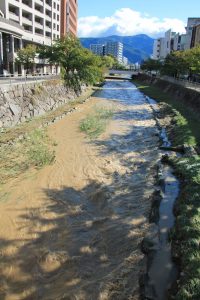Typhoon Hagibis: The Calm After the Storm

The way Typhoon 19, also known as Typhoon Hagibis, washed over eastern Japan yesterday you’d think the gods thought the world had caught fire. Record rainfall inundated the Kanto area as the storm made landfall in Shizuoka, passing over the Tokyo Metropolitan area under cover of the black black skies. Buses and trains and airplanes stood motionless. Offices and storefronts and homes sat shuttered up tight. Virtually all that was moving were the rushing, rising rivers.
In Matsumoto too the warnings went out, of rising river levels and potential evacuations. And though the rain had all but stopped by midnight last night, the rivers, I thought, would continue to rise, maybe for the next twenty-four if not forty-eight hours. It takes time for all that rainwater to run down from the mountains surrounding town.
So what I saw this morning came as quite a surprise.

The Susuki River runs down from the mountains of the east-lying Utsukushigahara highlands. As expected, its waters were muddy and swollen and restless. But rather than breaching the cement berms as I was expecting they would be by now, the Susuki was running well below the grassy banks lining both sides.
The worst is yet to come, I figured. Matsumoto had been hit by heavy rains similar to last night two or three times in the years I’ve lived here, and the Susuki River has always in those times turned turbulent in the aftermath. But not today. Not yet.

So my neck of the woods was all right, even normal save for the excess amounts of mud and water thrashing along the Susuki riverbed. A ride around town showed more of the same.



But a closer look at things brought a surprise – the realization that the rivers had already risen and fallen.

The flattened grass along the riverbanks, and the mud that coated it all…

… the telltale clumps of debris – more grass, mostly; maybe the tree branches broken off by the typhoon’s peripheral winds would come floating down later.

And while the crows picked through the mud-coated, washed-out riverbanks, ducks sunned themselves in the middle, on swaths of refuge that had apparently been overrun with flood waters overnight but had reemerged with the receding river.
Meanwhile the streets of town were dry. In the parks and the parking lots there were barely any puddles to be seen. Even the fruit trees seem to have escaped Hagibis’s wrath.

As menacing as Mother Nature can be, on this morning, at least, it seemed our little slice of the world had made it through intact, and was already on the return road to normalcy.
Man, on the other hand, would need a little more time, evidenced by the twenty-four hour supermarket not far from those ducks that was sitting still shut tight and closed.

But soon enough they too would open up their doors again. The muddy riverbanks would return to their breezy, grassy state. With any luck yesterday’s soba festival that was cancelled would be rescheduled.
In Tokyo the trains and buses are running again. Folks can still salvage the three-day weekend that Hagibis temporarily interrupted. But there was damage done too. And a few people, I hear, have gone missing.
So while we can revel in the sun and the blue skies that have so quickly returned, in the background are those quiet reminders that Mother Nature, indeed, can be fierce.
And next time things might not seem so peaceful come morning.